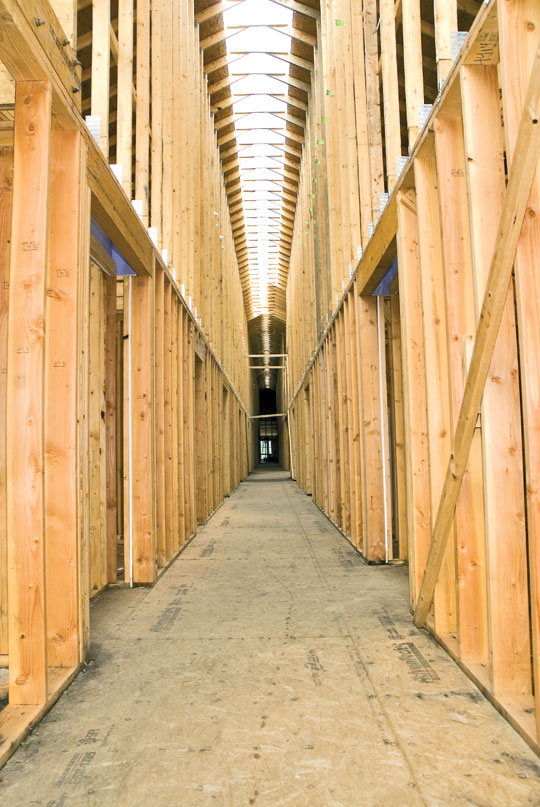The Makings of a Great Subfloor
| Subflooring in Multifamily and Light Commercial Structures | ||
Floors for multifamily and light commercial structures will typically have four layers with the flooring system: joists, which form the bottom-most layer that supports the entire floor; the subfloor; an underlayment, usually a thin layer of gypsum concrete; and the finish floor. Because the construction process exposes the structure to the elements far longer than for a single-family home, the importance of a subfloor that does not absorb moisture is critical. A low-quality subfloor could lead to issues such as delamination or edge swelling resulting in thin spots and cracks in the gypsum concrete. Drilling small holes in OSB panels to drain standing water may actually cause the gypsum/concrete underlayment to drain to floor below, creating safety issues. In addition, because the gypsum/cementitious underlayment is not structural and only provides sound attenuation, fire resistance, and thermal mass, the subfloor must be sufficiently strong to carry the load. For projects like hotels where floors receive long-term heavy traffic, costly repairs can be reduced by using a high performance subfloor that can resist the abuse over time from traffic as well as from heavy moisture due to extended exposure times. Heavy traffic during construction, particularly concentrated in the corridor areas, can cause severe damage in lower-quality floors. This could result in initial costs during construction to repair the issues and also during the service life of the building if the floor strength is compromised. Replacement of panels in these projects could be particularly costly if swelling occurs due to moisture. The scale is larger, and the thickness swell of 1/8 inch per floor can add up. If this swelling occurs on four floors, that results in a building change of 1/2 inch, a situation that will affect many other aspects of the structure.
|
Subfloors for Superior Performance
The finished floor of a building is only as good as the subfloor beneath it. Ideally, the finished floor will be strong and moisture resistant to avoid problems down the road such as sub-floor squeaks that lead to recalls and repair, and mold and mildew that can cause serious health issues for building occupants. While plywood and traditional OSB have long been mainstays of the subflooring world, high performance panels with increased wood density and enhanced resins exceed the capabilities of traditional subfloor panels in strength, stiffness, nail holding capacity and moisture resistance. Used successfully throughout the U.S. for more than a decade, high performance subflooring offer architects a reliable tool in designing safe, comfortable structures that meet occupants' expectations.
 |
Huber Engineered Woods LLC, a wholly owned subsidiary of J.M. Huber Corporation, combines advanced resin and wood product technologies with state-of-the-art manufacturing capabilities to develop top-quality products like AdvanTech® subflooring and ZIP System® sheathing. Find out more about these innovative products by visiting Huber’s online architect library www.huberarchitectlibrary.com |









